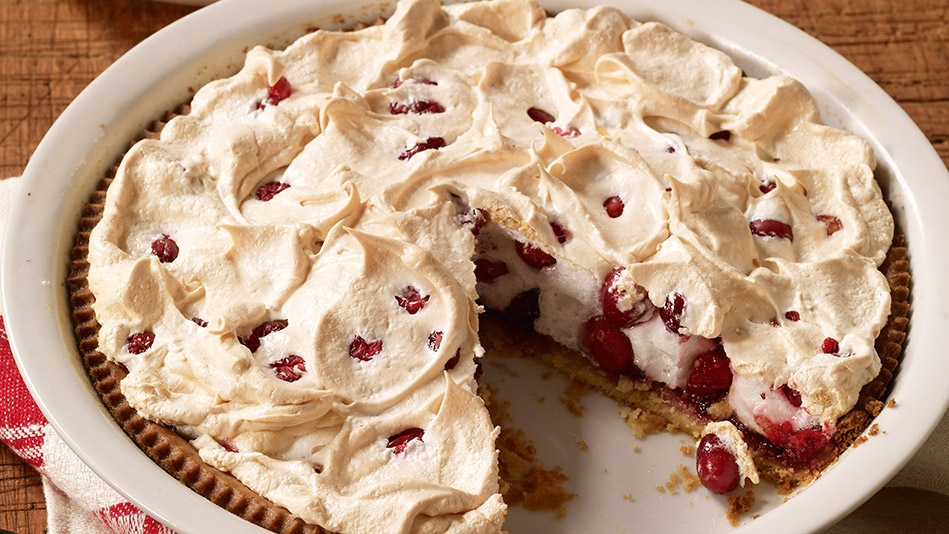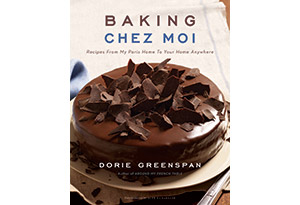Cranberry Crackle Tart Recipe

Photo: Alan Richardson
The tart has three layers, each adding something different to the mix. The crust is sweet and crisp, and so purposefully low, I think of it as a platter. The thin layer of thick jam is there for flavor, texture and insulation—it's like a barrier island between the dry base and the moist crown. The topping is a fluff of marshmallowy meringue and fresh cranberries, a mixture of sweet and tart that bakes to a crackle finish. I love the contrasts and the way the surface of the meringue turns crunchy, while underneath, it remains soft and snow white.
Serves 6
For the tart dough:1 1/2 cups all-purpose flour
1/2 cup confectioners' sugar
1/4 tsp. fine sea salt
9 Tbsp. (4 1/2 ounces) very cold, unsalted butter, cut into small pieces
1 large egg yolk
For the filling: 2 Tbsp. chunky cherry, raspberry or strawberry jam
2 large egg whites, at room temperature
Pinch of fine sea salt
1/2 cup sugar
1 1/2 cups cranberries (if they're frozen, don't thaw)
Confectioners' sugar, for dusting (optional)
Make the dough: Put the flour, confectioners' sugar and salt in a food processor and pulse a couple of times to blend. Scatter the pieces of butter over the dry ingredients and pulse until the butter is cut in coarsely—you'll have some pieces the size of oatmeal flakes and some the size of peas. Stir the yolk just to break it up and add it a little at a time, pulsing after each addition. When the egg is incorporated, process in long pulses—about 10 seconds each—until the dough, which will look granular soon after the egg is added, forms clumps and curds. Just before you reach this clumpy stage, the sound of the machine working the dough will change—heads-up. Turn the dough out onto a work surface.
To incorporate the butter more evenly and to catch any dry ingredients that might have escaped mixing, separate small amounts of dough from the pile and use the heel of your hand to smear each piece a few inches across the counter. In French, this is called fraisage, and it's the ideal way to finish blending a dough.
Shape the dough into a disk and put it between two sheets of parchment or wax paper. Roll the dough out evenly, turning it over frequently and lifting the paper often so that it doesn't roll into the dough and form creases. Aim for a circle that's at least 3 inches larger than the base of your tart pan. The dough will be 1/8- to 1/16-inch thick, but it's the diameter, not the thickness, that counts. Slide the rolled-out dough, still between the papers, onto a baking sheet or cutting board and refrigerate for 2 hours, or freeze it for 1 hour. (The dough can be refrigerated overnight or frozen for up to 2 months; wrap it airtight to freeze.)
When the dough is thoroughly chilled, put it on the counter and let it rest for about 10 minutes, or until it's just pliable enough to bend without breaking. Butter a 9-inch pie pan (I use a Pyrex pan) and place it on a baking sheet lined with parchment paper or a silicone baking mat.
Sandwich the dough between two sheets of parchment or wax paper and roll it out until it is a scant 1/8-inch thick. Don't worry about making a beautiful circle, because you're going to trim the dough.
Fit the dough into the pie pan, allowing the excess to drape over the sides. Gently press the dough evenly over the bottom and up the sides of the pan and then, using a paring knife, a pizza wheel or a fluted ravioli wheel, trim the dough to about one third down from the rim of the pan. Prick the bottom of the tart shell all over with a fork and freeze for at least 30 minutes. (The leftover dough makes a nice turnover.)
Center a rack in the oven and preheat the oven to 400°.
Line the crust with a piece of parchment or a buttered piece of aluminum foil and weight it down with rice, dried beans or light pie weights. Bake the crust for 20 minutes, then carefully remove the paper and weights and bake for 8 to 12 minutes more, or until the crust is golden. The crust will have shrunk, but that's fine. Set the crust on a rack to cool to room temperature.
When you're ready to fill and bake the tart: Preheat the oven to 300°.
Spoon the jam into the crust and spread it evenly over the bottom. Working in the bowl of a stand mixer fitted with the whisk attachment, or in a large bowl with a hand mixer, beat the egg whites with the salt at medium speed just until they turn opaque. With the mixer going, add the sugar in a very slow, steady stream; then, keep beating until the whites are shiny and form peaks with pretty, droopy tips (they will look like marshmallow).
Pour the cranberries into the bowl and, using a flexible spatula, fold them into the meringue. Try to distribute the fruit evenly, but don't try too hard—you want to keep the meringue fluffy. Turn the meringue over the jam and spread it to the edges, making it swirly if you'd like. The jam will sneak up around the sides of the meringue, and that's fine.
Bake the tart for 1 hour, at which point the top will be light beige and most probably cracked here and there. (If you'd like more color, you can bake it longer or put it under the broiler.) Transfer the tart to a cooling rack and cool to room temperature. If you'd like, dust the tart with confectioners' sugar before serving.
The tart is best served the day it's made, although it's still pretty nice a day later. Leave the tart at room temperature, covering only the cut part with a piece of wax paper or plastic film.
 Excerpted from Baking Chez Moi, © 2014 by Dorie Greenspan. Reproduced by permission of Houghton Mifflin Harcourt. All rights reserved.
Excerpted from Baking Chez Moi, © 2014 by Dorie Greenspan. Reproduced by permission of Houghton Mifflin Harcourt. All rights reserved.
Serves 6
Ingredients
For the tart dough:
For the filling:
Directions
Make the dough: Put the flour, confectioners' sugar and salt in a food processor and pulse a couple of times to blend. Scatter the pieces of butter over the dry ingredients and pulse until the butter is cut in coarsely—you'll have some pieces the size of oatmeal flakes and some the size of peas. Stir the yolk just to break it up and add it a little at a time, pulsing after each addition. When the egg is incorporated, process in long pulses—about 10 seconds each—until the dough, which will look granular soon after the egg is added, forms clumps and curds. Just before you reach this clumpy stage, the sound of the machine working the dough will change—heads-up. Turn the dough out onto a work surface.
To incorporate the butter more evenly and to catch any dry ingredients that might have escaped mixing, separate small amounts of dough from the pile and use the heel of your hand to smear each piece a few inches across the counter. In French, this is called fraisage, and it's the ideal way to finish blending a dough.
Shape the dough into a disk and put it between two sheets of parchment or wax paper. Roll the dough out evenly, turning it over frequently and lifting the paper often so that it doesn't roll into the dough and form creases. Aim for a circle that's at least 3 inches larger than the base of your tart pan. The dough will be 1/8- to 1/16-inch thick, but it's the diameter, not the thickness, that counts. Slide the rolled-out dough, still between the papers, onto a baking sheet or cutting board and refrigerate for 2 hours, or freeze it for 1 hour. (The dough can be refrigerated overnight or frozen for up to 2 months; wrap it airtight to freeze.)
When the dough is thoroughly chilled, put it on the counter and let it rest for about 10 minutes, or until it's just pliable enough to bend without breaking. Butter a 9-inch pie pan (I use a Pyrex pan) and place it on a baking sheet lined with parchment paper or a silicone baking mat.
Sandwich the dough between two sheets of parchment or wax paper and roll it out until it is a scant 1/8-inch thick. Don't worry about making a beautiful circle, because you're going to trim the dough.
Fit the dough into the pie pan, allowing the excess to drape over the sides. Gently press the dough evenly over the bottom and up the sides of the pan and then, using a paring knife, a pizza wheel or a fluted ravioli wheel, trim the dough to about one third down from the rim of the pan. Prick the bottom of the tart shell all over with a fork and freeze for at least 30 minutes. (The leftover dough makes a nice turnover.)
Center a rack in the oven and preheat the oven to 400°.
Line the crust with a piece of parchment or a buttered piece of aluminum foil and weight it down with rice, dried beans or light pie weights. Bake the crust for 20 minutes, then carefully remove the paper and weights and bake for 8 to 12 minutes more, or until the crust is golden. The crust will have shrunk, but that's fine. Set the crust on a rack to cool to room temperature.
When you're ready to fill and bake the tart: Preheat the oven to 300°.
Spoon the jam into the crust and spread it evenly over the bottom. Working in the bowl of a stand mixer fitted with the whisk attachment, or in a large bowl with a hand mixer, beat the egg whites with the salt at medium speed just until they turn opaque. With the mixer going, add the sugar in a very slow, steady stream; then, keep beating until the whites are shiny and form peaks with pretty, droopy tips (they will look like marshmallow).
Pour the cranberries into the bowl and, using a flexible spatula, fold them into the meringue. Try to distribute the fruit evenly, but don't try too hard—you want to keep the meringue fluffy. Turn the meringue over the jam and spread it to the edges, making it swirly if you'd like. The jam will sneak up around the sides of the meringue, and that's fine.
Bake the tart for 1 hour, at which point the top will be light beige and most probably cracked here and there. (If you'd like more color, you can bake it longer or put it under the broiler.) Transfer the tart to a cooling rack and cool to room temperature. If you'd like, dust the tart with confectioners' sugar before serving.
The tart is best served the day it's made, although it's still pretty nice a day later. Leave the tart at room temperature, covering only the cut part with a piece of wax paper or plastic film.
 Excerpted from Baking Chez Moi, © 2014 by Dorie Greenspan. Reproduced by permission of Houghton Mifflin Harcourt. All rights reserved.
Excerpted from Baking Chez Moi, © 2014 by Dorie Greenspan. Reproduced by permission of Houghton Mifflin Harcourt. All rights reserved.



